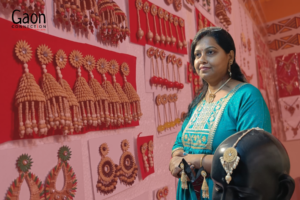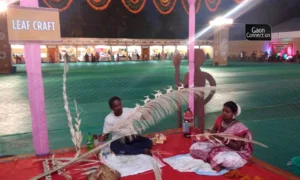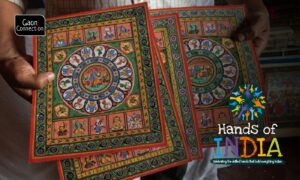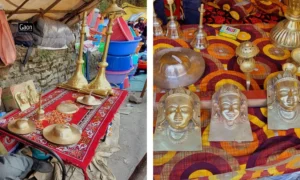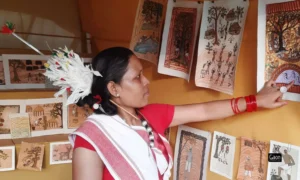Amadubi (East Singhbhum), Jharkhand
The people in the painting look like they will come alive any minute. A woman sweeps the courtyard, another one keeps a watchful eye on a cooking pot while farmers exchange tips as they plough their land. Elsewhere, on the mud wall of a hut, Adivasi women in all their finery are poised to launch into a dance, waiting for their menfolk to tune their dholaks, and trumpets.
Paitkar art, a traditional scroll painting that is indigenous to Jharkhand, is startlingly vibrant and tells stories of the times, of the lifestyle of the Paitkar community. The word Paitkar is derived from Patekar or Potikar, artists of the region, who through their work tell us about the customs, traditions and practices of the region.
Amadubi village in Dhalbhumgar block of East Singhbhum district is world famous for this unique art form. Sadly, it looks like the music will fade away and the dancers won’t dance again as the folk art is in serious decline due to lack of patronage.
There are 45 Paitkar families in Amadubi village and there was a time when all these families were involved in traditional scroll painting. But only six or seven young villagers remain, who continue to paint. Other young artists have put down their brushes to work as daily wage labourers.

Moni Chitrakar is the sole woman artist from Amadubi. The 35-year-old said that it was becoming increasingly difficult to keep up the art. “The scroll painting is famous for its natural colours that are made and preserved using traditional methods without any chemicals. But it has stopped bringing any colour into the life of artists,” she told Gaon Connection.
Also Read: The 12th century craft of Pipili work in Odisha losing its vibrancy
“The light red colour we use comes from the palash flower, the green from the leaves of the flat beans creeper, purple is extracted from spinach seeds, the yellow from turmeric, and so on,” the Paitkar artist explained. Other natural products like gum from the neem tree are used to protect the painting from insects; Acacia gum is used to brighten the colours while many other colours are taken from different kinds of stones and rocks, she added.
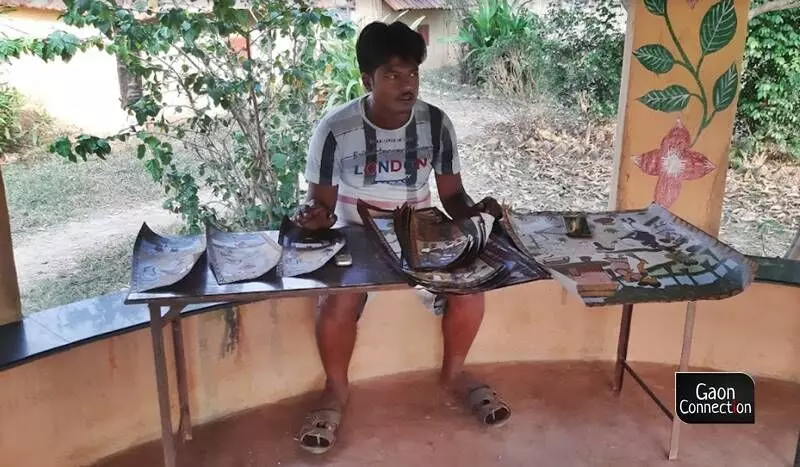
Paitkar art is indigenous to Jharkhand, but sadly it has seen steep decline as there are not enough art lovers and organisations to preserve and promote the centuries old art.
The Amadubi Panijia Gramin Paryatan Kendra, a tourist centre that was set up in 2013, displays her paintings besides that of artistes Vijay Chitrakar, Anil Chitrakar, Subhash Chitrakar, Ganesh Gayan and Kishore Gayan.
“Each of the artistes is left with hundreds of paintings as there is no one to buy them,” Kishor Gayan, another Paitkar scroll artist from Amadubi village, told Gaon Connection.
Kishor Gayan comes from a long line of artists but was forced to abandon his art for a while to make ends meet. The 26-year-old artist left his village and travelled over 200 kilometres away to Kolkata in the neighbouring state of West Bengal to earn a living. But it was not long before Paitkar art tugged him back home. He is now occupied painting stories on long scrolls as it has been done traditionally.
An art that dates back to the Gupta Empire
Kishor Gayan learnt the history of his community from his grandfather Bhutunath Gayan, also an artist. He learnt that the Paitkar community had come to Dhalbhumgar area in Jharkhand (where Amadubi village is situated) from West Bengal during the Gupta dynasty, that ruled from the early 4th century CE to late 6th century CE. The community was homeless and moved from place to place making music and paintings.
The story goes that when this community of artistes came to the notice of Ramchandra Dhar, the ruler of Dhalbhumgar, he invited its members to participate in an art competition. “Members of five Paitkar families took part and won the competition, defeating a famous group of artists from Bankura in West Bengal. The king sanctioned 1,005 bighas of land to the winning artists and that is how they came to be in Amadubi,” Gayan narrated the history to Gaon Connection.
Paitkar art is indigenous to Jharkhand, but sadly it has seen steep decline as there are not enough art lovers and organisations to preserve and promote the centuries old art. As a consequence, many practitioners of Paitkar art have left in search of more paying opportunities.
The COVID-19 pandemic dealt a further blow as tourism and art fairs where the artists could have showcased their work came to a grinding halt.
“Paitkar scrolling painting is our identity. I want to bring back its lost glory. If we are engaged for ten days in a month in workshops, the money we earn will keep us going and help us support our families,” Kishor Gayan pointed out. “If Jharcraft (Jharkhand Silk Textile & Handicraft Development Corporation Ltd. that was formed in 2006), the state government and other culture based organisations come forward to help us in marketing our art, we would remain in this profession and never abandon it,” he said.
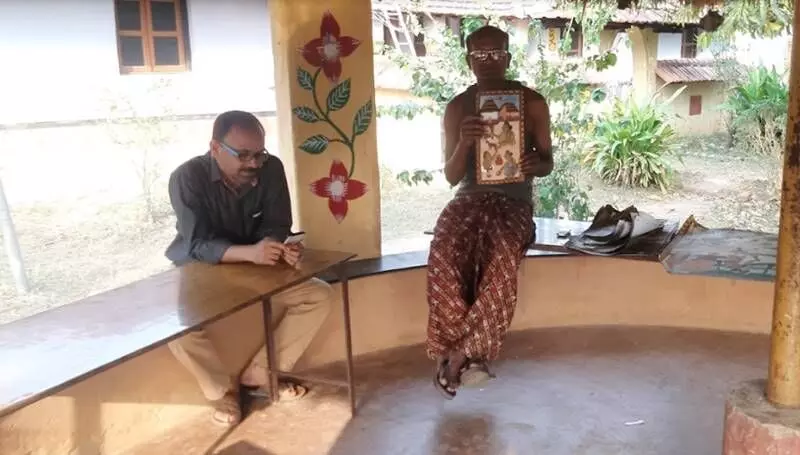
Kishor Gayan’s father Sushil Gayan gave up painting as he could not support his family with what he made from his art. “I don’t want to do what my father had to do. But, government apathy may force many of us to stop creating art,” the Paitkar artist feared.
Pandemic’s blow
Prior to the pandemic and the lockdown, things were not so bad, said Paitkar artists from Amadubi village. Tourists from West Bengal, Andhra Pradesh, Kerala, Delhi, Maharashtra, Tamil Nadu, Madhya Pradesh and Delhi visited Amadubi to see the indigenous art of Jharkhand. Paitker paintings were also sold to art lovers from other parts of the world.
“Workshops and sales are organised by Jharcraft, Kalamandir and the state government,” said senior artist Subhash Chitrakar, who is 72 years old and has just returned from workshops in Hazaribagh and Ranchi. “A few government officials take interest in indigenous art and purchase them at such workshops. The deputy secretary of the forest department, Sanjeev Kumar Singh, bought a painting and assured the Paitkar artists of departmental support,” Subhash Chitrakar told Gaon Connection. “It is official support that keeps us motivated and keeps us going,” he added.
Also Read: The whisper of the world-famous Banka silk from Bihar is being silenced
In 2003, Kalamandir, an organisation that supported art and culture, came to Amadubi and held a number of workshops and began marketing Paitkar art in and outside Jharkhand. It was support from the Kalamandir that persuaded Kishor Gayan to return to his traditional art. Even during the pandemic, Kalamandir encouraged artists to paint on masks, which not only promoted the art but also earned the artists a livelihood.
But many artists feel that painting scrolls are not worth the effort, time and money they put into it. “Previously, we earned around six thousand rupees a month selling paintings. The pandemic put a stop to that. Many of us were reduced to a hand to mouth existence,” artist Ganesh Gayan from Amudubi, told Gaon Connection. “Now the artists barely make three thousand rupees a month as there is next to no footfall at the tourist centre in Amadubi and few workshops,” the 28-year-old added.
Need to revive the Paitkar art
“Paitkar art is scrolling towards its end,” declared Kalkant Gope, secretary of Gramin Paryatan Vikas Samiti, Amadubi, that runs the village tourist centre. “While the state government had come up with a tourist centre in September 2013 in Amadubi, and . several hundred tourists visited every year, the last couple of years have seen only a trickle of people. It has affected the survival of Paitkar painters’ families,” Gope told Gaon Connection.
Paitkar artists are forced to exhibit their beautiful works in restaurants and sundry stores, where they hope some art lovers will spot them. “If the state government and cultural organisations do not step up to lend us a helping hand, Paitkari art, which has been around since the Gupta dynasty, will cease to exist,” Kishore Gayan warned.
Despite all the odds, artists like Kishor Gayan have not lost hope. He teaches the art to 20 local children free of cost. “The children love to dabble in the colours and paint stories with them. They think making colours from natural resources is great fun,” smiled Kishor Gayan. But he also knows that without support, it may be an uphill task to ensure Paitkar art doesn’t disappear from the face of Jharkhand.







